INTRODUCTION
The Fujinon XF100-400mm f/4.5-5.6 R LM OIS WR is a super-telephoto lens designed for Fujifilm’s range of X-mount mirrorless cameras.
It was announced in January 2016 and to date, it is the longest focal length lens in the Fujifilm lens range. It produces a field of view of approximately 150-600mm on the APS-C sensor of the X-series cameras.
The lens retails in the United Kingdom at around £1,500 or with the 1.4x teleconverter (XF 1.4x TC WR) included, £1609.
Please see notes at the end of this review regarding retail prices and links.
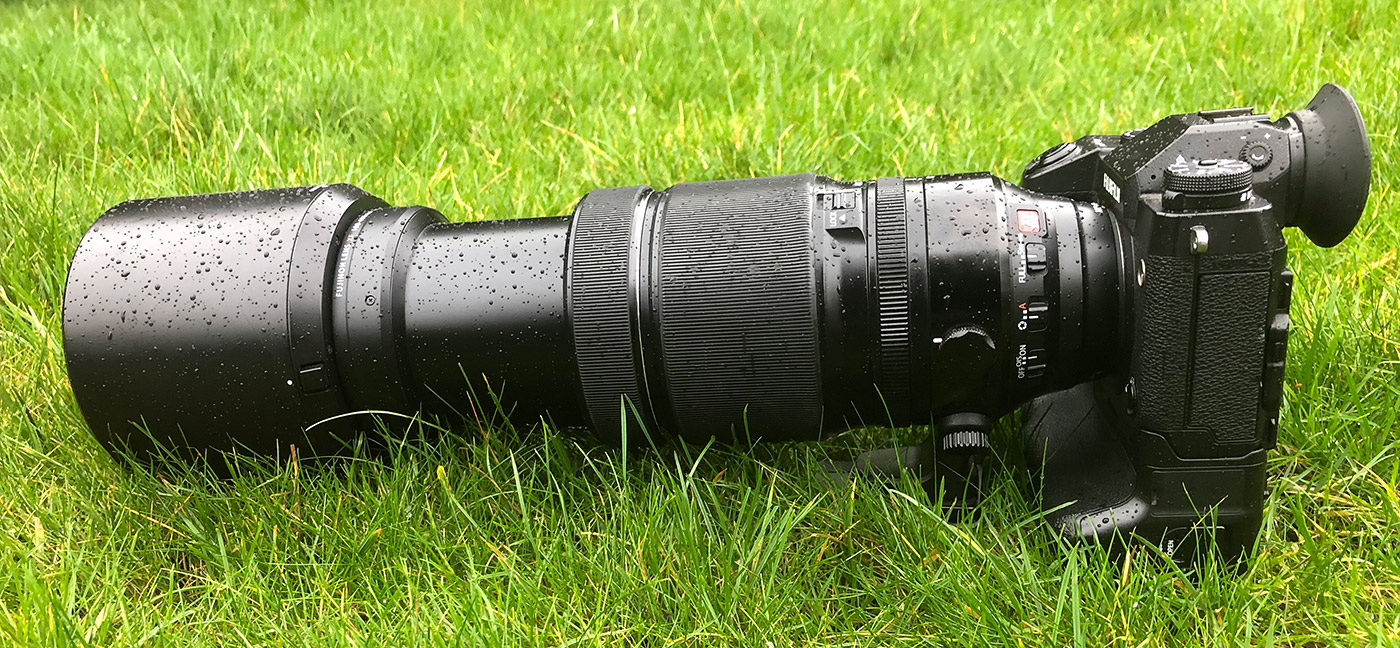
The Fujinon (Fujifilm) 100-400mm f/4.5-5.6 attached to the Fujifilm X-H1
WHAT’S IN A NAME?
The XF100-400mm f/4.5-5.6 R LM OIS WR – The ‘R’ designation means the lens has a dedicated aperture ring. ‘LM’ means the lens is equipped with fast and near-silent lens focusing motors. ‘OIS’ is the Fujifilm term for optical stabilisation and ‘WR’ tells us the lens is fitted with weather resistant sealing.
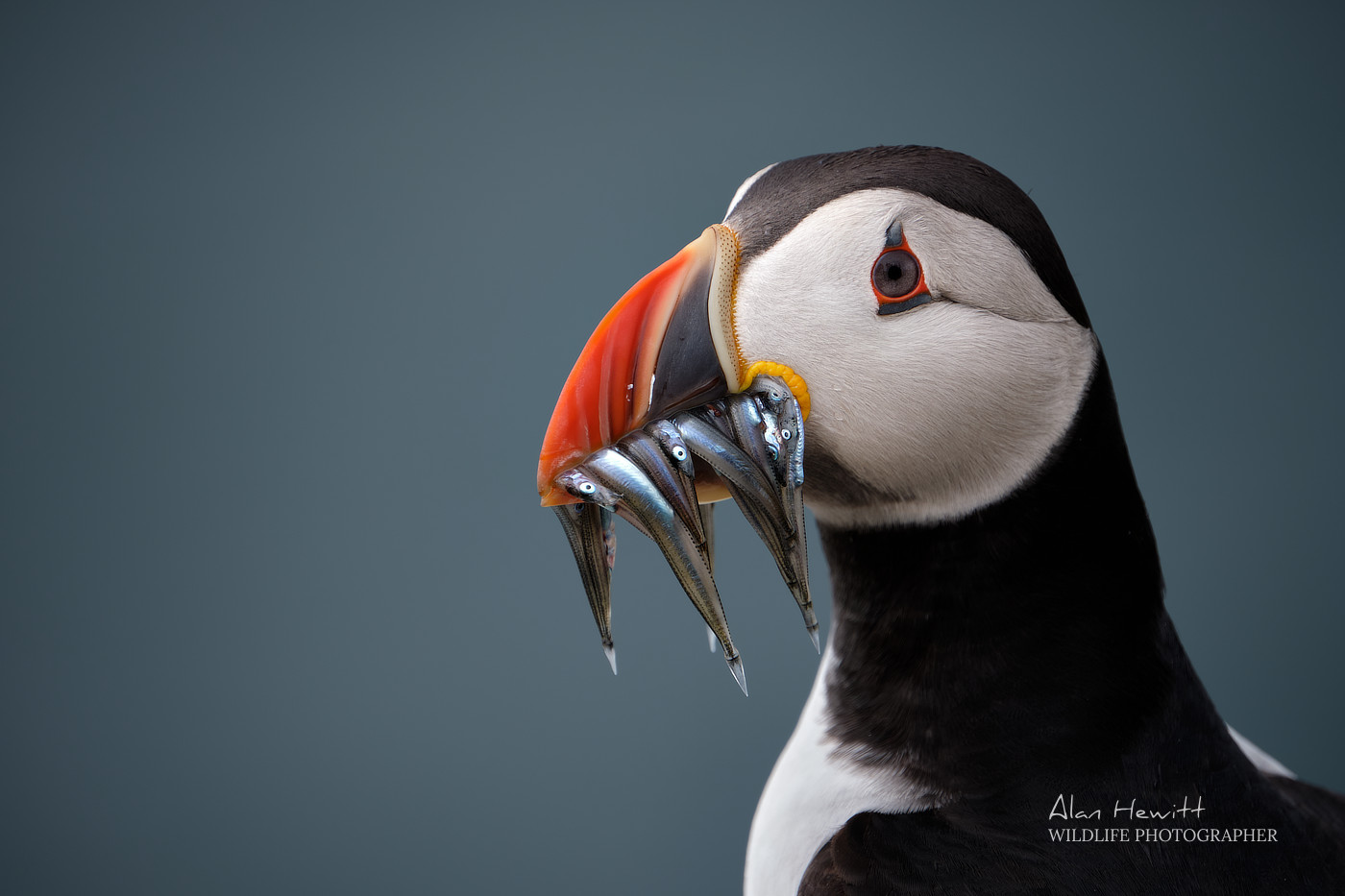
Atlantic Puffin – Fujifilm X-H1 & Fujinon 100-400mm f/4.5-5.6 (1/320, f/5.6, ISO200, 400mm)
THE SPECS
| Overview: | |
| Full designation | FUJINON XF100-400mm f/4.5-5.6 R LM OIS WR |
| Format | APS-C |
| Mount | Fujifilm-X |
| Stabilisation | 5 Stops |
| Weight | 1375g |
| Diameter | 94.8mm |
| Length | 210.5mm-270mm |
| Sealing | Yes |
| Filter size | 77mm |
| Tripod Collar | Yes |
| Aperture: | |
| Maximum Aperture | f/4.5 – f/5.6 |
| Minimum Aperture | f/22 |
| Diaphragm | 9 Blades |
| Aperture Ring | Yes |
| Focusing: | |
| Minimum Focus Distance | 1.75m |
| Internal Focus | Yes |
| Limiter | Full and 5m to infinity |
| Optics: | |
| Elements | 21 Elements in 14 groups |
BUILD QUALITY AND ERGONOMICS
Let’s start at the mount and move forward. As we would expect, we have a metal mount and visible weather sealing gasket. Throughout the lens are a total of 13 water and dust resistant seals in 12 locations.
I’ve used this lens many times in the dusty environments of Kenya’s Masai Mara and South Africa’s Greater Kruger and I’m yet to notice any ingress.
Lens operation buttons for focus limiting, aperture control and OIS are easily accessible and changeable in their position on the left hand side (as we operate the camera and lens).
The overall weight of the lens is minimised by a plastic barrel construction. Don’t be put off by this, it’s very tough and such is the durability and quality, for a while I believed it to be metal.
The aperture ring gives us a reassuring, positive and precise tactile feel as we make adjustments in 1/3 stop increments. Given that this is a variable aperture lens which is dependent on focal length, there are no aperture markings like we would see on a constant aperture zoom or prime lens. You can, of course, choose to operate the aperture from the camera body instead if you wish.
The metal tripod ring allows the lens to be easily rotated between landscape and portrait orientation when mounted on a tripod or monopod. The foot is easily detachable with knurled thumb screws. I often detach this tripod mount when travelling for ease of packing.
The tripod mount foot feels a little bit too small. I often like to carry a telephoto by the tripod mount so I would personally prefer something a little more substantial to grip. Maybe in future versions of this lens we may also see a moulded Arca Swiss plate like the more recent Fujinon 200mm f/2. Although Arca-Swiss compatible plates are abundant in availability and choice, it would be a nice touch to have this as standard.

Male Lion – Fujifilm X-H1 & Fujinon 100-400mm f/4.5-5.6 (1/200, f/5.6, ISO800, 400mm)
Focal length markings are at 100mm, 135mm, 200mm, 300mm and 400mm. A zoom lock switch prevents any creeping when carrying the lens retracted at 100mm. I also use this lock when the lens is packed to prevent it extending when retrieving it from my bag.
A large zoom ring takes about quarter of a turn to go through the full focal range of 100 to 400mm. This prevents zooming when hand held becoming a chore, unlike some other zoom lenses I have used. The zoom ring is well positioned in conjunction with the aperture ring. When hand holding, I can rest the barrel in the palm of my hand while alternating operation of the the zoom and aperture ring with my thumb.
The manual focus ring is rather small. Personally, I don’t routinely manual focus with a telephoto lens like this, nor do I think many others do. So, I don’t find the thin size an issue. Giving the majority of available space to the zoom ring is far more favourable for ergonomic handling.
Focussing is internal so the front element does not rotate, faciltating simple use of polarisers and neutral density graduated filters.
The front element has a fluorine coating to help repel contaminants. It does feel rather heavy and a little unbalanced towards the front, so I prefer to use this lens with the additional Vertical Power Booster Grips on both my X-T2 and X-H1 to achieve more overall balance. I also feel the enhanced grip on the X-H1 to be more beneficial in this regard.
The lens hood is also made of tough plastic. It locks into place with a very reassuring tactile click and requires unlocking to remove. There is a sliding opening portal to allow access to adjust a polariser filter. When not in use, the hood is easily and quickly stored in a reversed position.

Fujifilm 100-400 f/4.5-5.6 (Left) Lens hood with filter access portal open, (Right) At 100mm without lens hood attached.

Fujifilm 100-400 f/4.5-5.6 (Left) Extended to 400mm with lens hood attached, (Right) Retracted at 100mm with lens hood attached.
AUTOFOCUS
The twin linear AF system is barely audible and when used with a modern camera body which is set up appropriately for optimum AF performance, it is also very quick and responsive.
The inclusion of a focus limiter switch is a crucial benefit. Most AF systems ‘hunt’ for focus more when they are looking for closer subjects. If we can tell the lens not to focus on close subjects, we can speed up AF and increase accuracy significantly. We have two options, ‘Full’ and ‘5m to infinity’. If we know our subject is not going to come within 5m of our position, by setting the limiter to 5m to infinity we exclude the AF hunting between the minimum focus distance of 1.75m and 5m.
I do miss programmable AF memory presets which I used a lot with my Nikon 200-400 f/4. When alternating between two subjects, or perhaps waiting for a subject you expect will imminently appear at a certain distance, like a perched bird for example, it was useful to be able to program the AF setting and quickly select it by means of the memory recall button.
These have been included in the more recent 200mm f/2 so maybe it is something we may also see in a future version of the 100-400mm.

Atlantic Puffin – Fujifilm X-H1 & Fujinon 100-400mm f/4.5-5.6 (1/2200, f/5.6, ISO1000, 270mm)
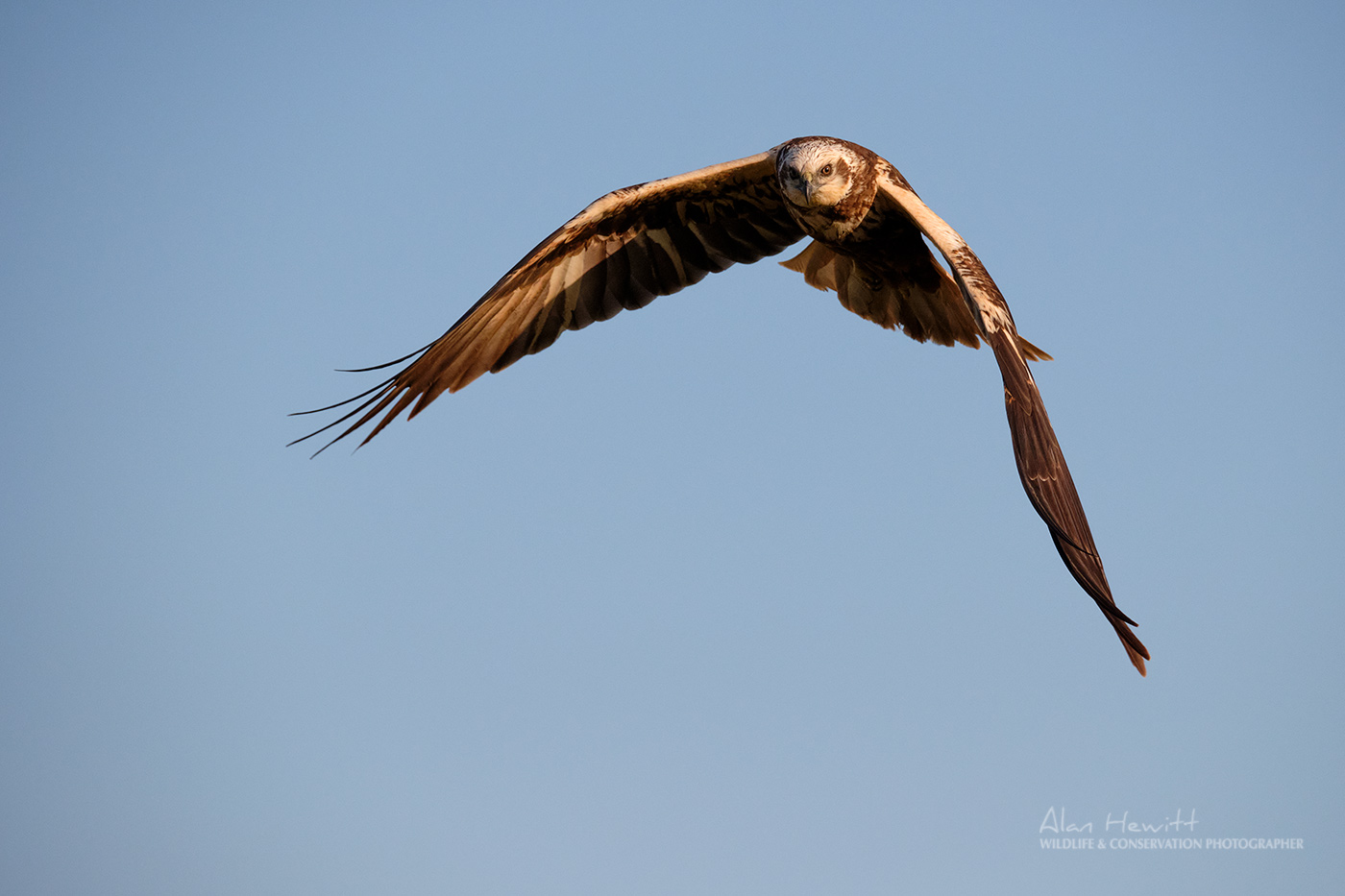
Marsh Harrier – Fujifilm X-H1 & Fujinon 100-400mm f/4.5-5.6 (1/2700, f/5.6, ISO1250, 261mm)
VARIABLE APERTURE
I’ve blogged about the variable aperture of the 100-400mm lens previously, here.
The total difference is between f/4.5 at 100mm and f/5.6 at 400mm. Here we can see where the aperture closes down as we move from 100mm to 400mm:
| Focal Length |
100 | 107 | 128 | 153 | 183 | 280 | 323 | 347 |
| Widest Aperture |
f/4.5 | f/4.6 | f/4.7 | f/4.8 | f/5 | f/5.2 | f/5.4 | f/5.6 |
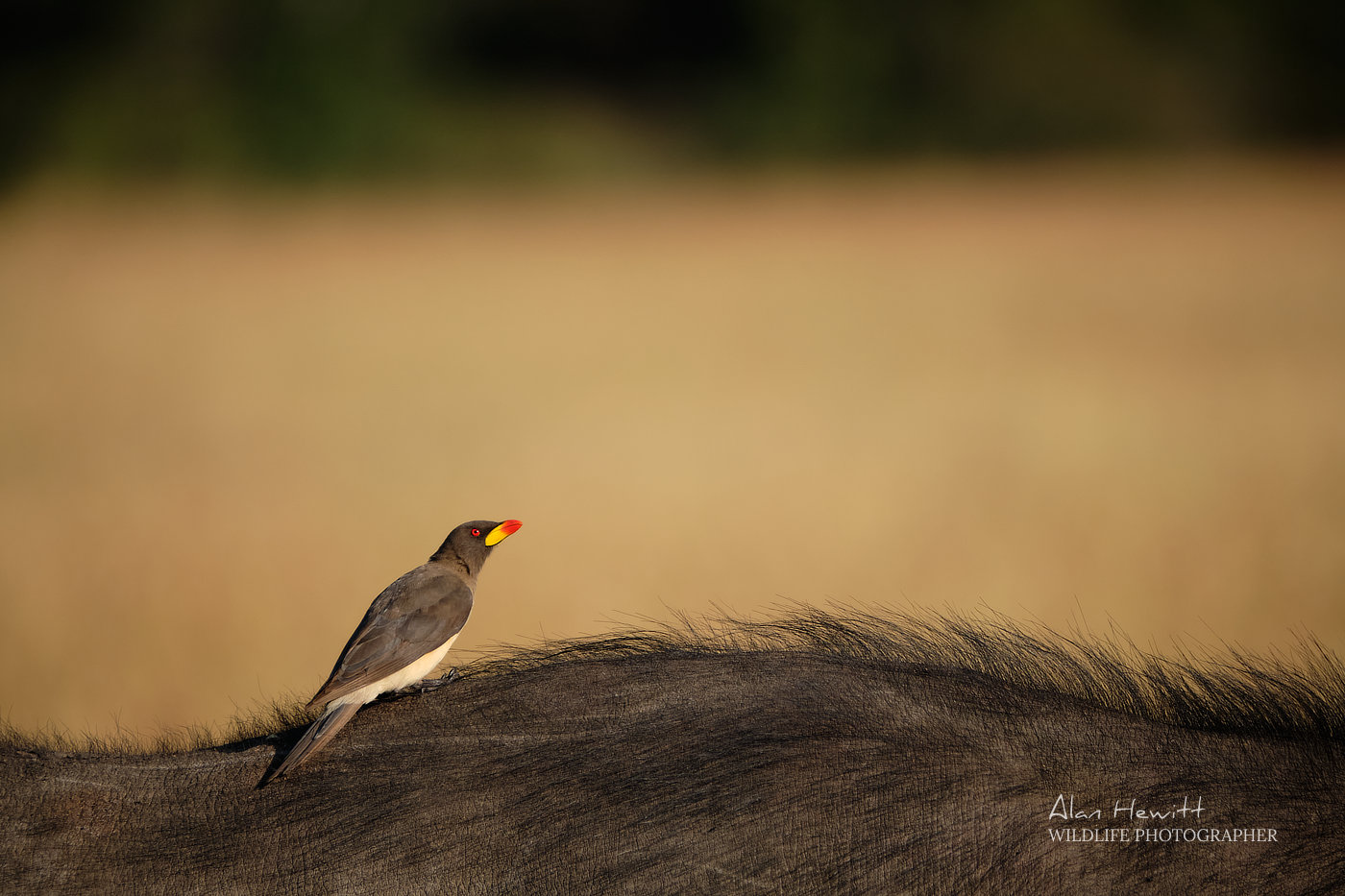
Yellow-billed Oxpecker (On Cape Buffalo!) – Fujifilm X-H1 & Fujinon 100-400mm f/4.5-5.6 (1/1800, f/5.6, ISO400, 400mm)
SHARPNESS
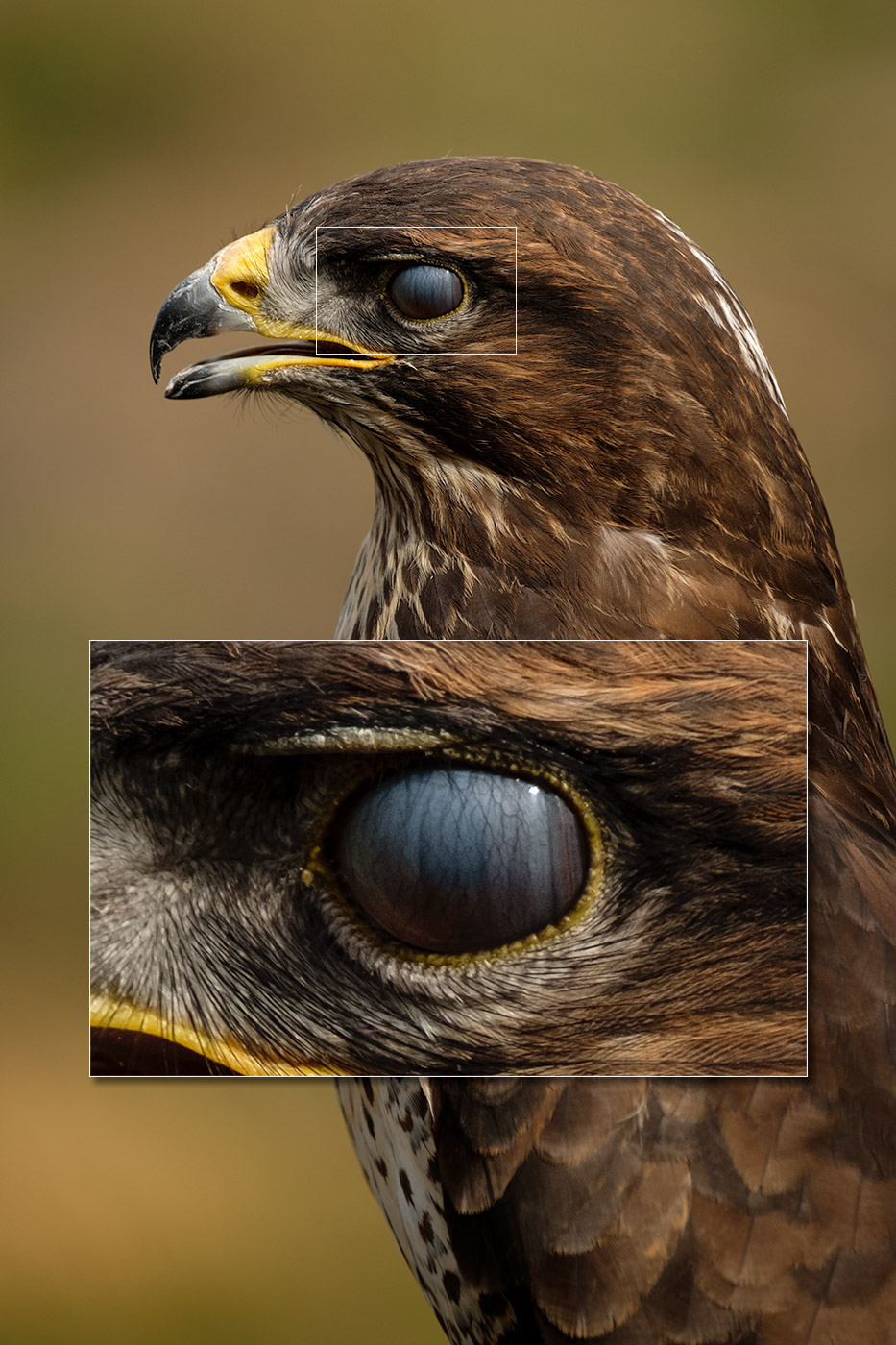
An eye for detail! Fujifilm X-H1 & Fujinon 100-400mm f/4.5-5.6 (1/1250, f/5.6, ISO400, 400mm)
I’m not going to reproduce MTF charts, they’re available elsewhere and I prefer to judge photographs.
Let’s get straight to the point! The overall sharpness of the 100-400mm is very impressive. If we wind the clock back a couple of years, it was the sharpness of this lens which made my decision to convert from Nikon to Fujifilm. You can read more about my thoughts during the transition between Nikon and Fujifilm here.
This photograph to the right of a captive Common Buzzard is a great example. It was taken on one of my wildlife photography techniques birds of Prey workshops. As I took the shot (at 400mm), the bird closed its nictitating membrane (third eyelid). When I reviewed the photograph I was absolutely astonished at the detail rendered in the membrane. When magnified at 400%, we can easily see the tiny blood-filled capillaries and leading edge of the membrane which have been rendered with incredible detail.
At 100mm to 200mm the sharpness is outstanding through f/4.5 to f/16 where it begins to drop off towards f/22.
From 200mm towards 300mm the sharpness is excellent, wide open and peaks around f/8-f/11 after which it drops very slightly through to f/22 but does remain very good.
From 350mm onwards towards 400mm the central sharpness is excellent but it does drop slightly towards the edges. At 400mm between f/5.6 and f/8 it remains excellent but drop off is a little more noticeable towards the edges. This isn’t a surprise for a telephoto zoom and much of the time these areas will be rendered in a shallow depth of field anyway.
Consistent success with sharpness using any big telephoto requires good support or absolutely faultless hand-holding technique. The Fujifilm 100-400mm is no different but crucially, the underlying lens quality is present so success is certainly achievable.
COLOUR CONTRAST AND DISTORTION
The lens is constructed of 21 lens elements in 14 groups. Five of these are ED (extra-low dispersion) and one is Super ED. Together with some rather clever lens profiling this increases contrast, boosts colour to Fujifilm glory and controls chromatic aberrations very well.
Image distortion is negligible if existent at all. It should be mentioned that just like chromatic aberration, I don’t know how much of this is lens quality and how much is profiling. Either way, I don’t really care because the end results are fantastic!
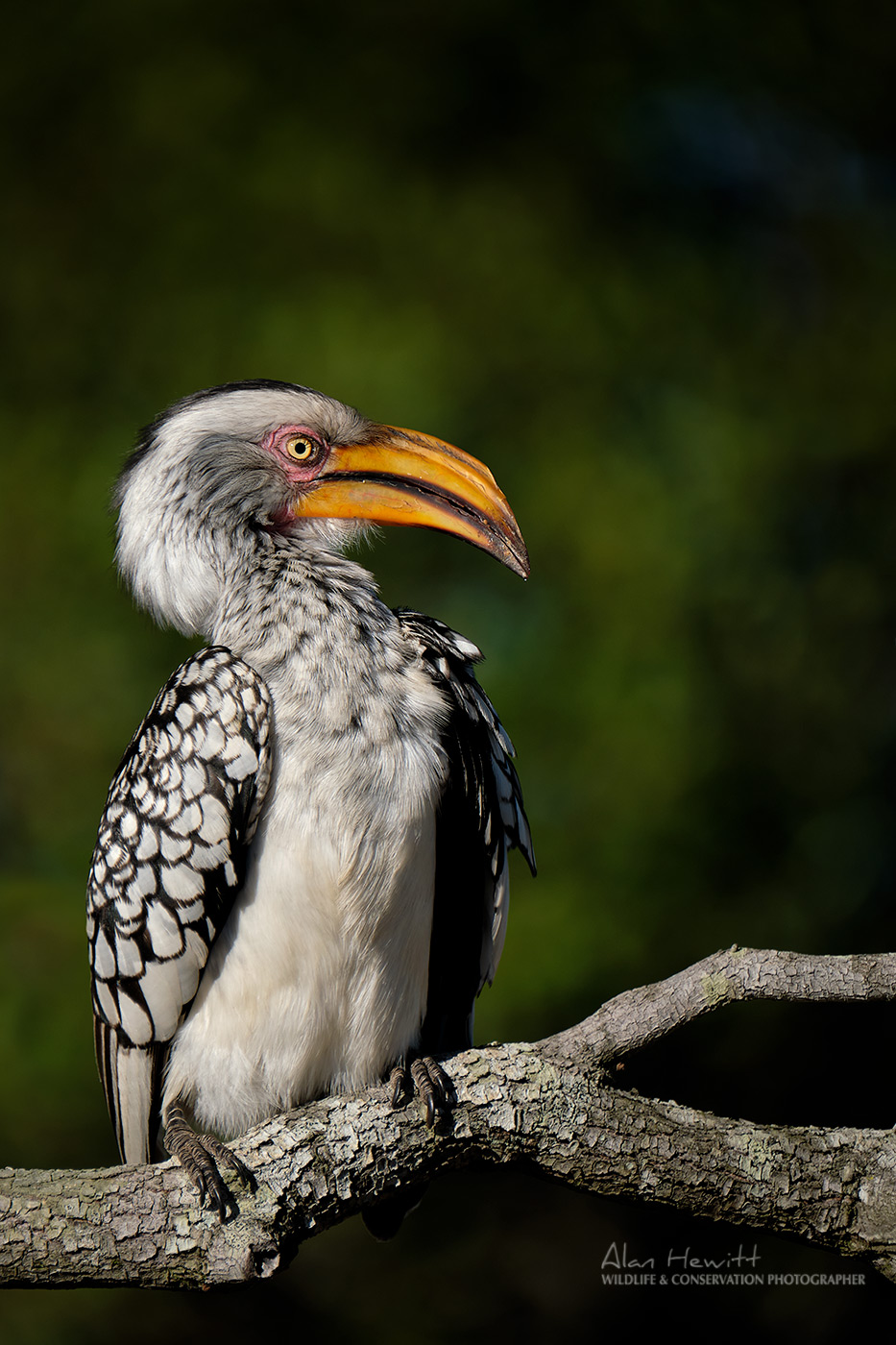
Southern Yellow-billed Hornbill – Fujifilm X-H1 & Fujinon 100-400mm f/4.5-5.6 (1/800, f/5.6, ISO200, 400mm)
OPTICAL STABILITY
The 100-400mm boasts five stops of Optical Image Stabilisation (OIS) which can also detect panning and compensate appropriately towards correcting unwanted vertical motion.
I don’t often use slower shutter speeds as subject movement usually requires me to keep my shutter speed faster than speeds where we could enthuse about getting sharp shots at 1/25 etc.
That said, I do find OIS a huge benefit in negating camera shake when hand-holding the 100-400mm lens for a long period, perhaps when awaiting some interesting subject behaviour or tracking birds in flight, for example.
I mostly use the 100-400mm lens coupled with the X-H1 camera which also has in-body image stabilisation (IBIS). When used together, the camera employs an intelligent approach to provide optimum stability. A lens like 100-400mm is more likely to require IBIS on vertical movement. As the lens OIS is optimised for this characteristic, the X-H1 will intelligently allow the lens OIS to stabilise movement on this axis. Very clever!
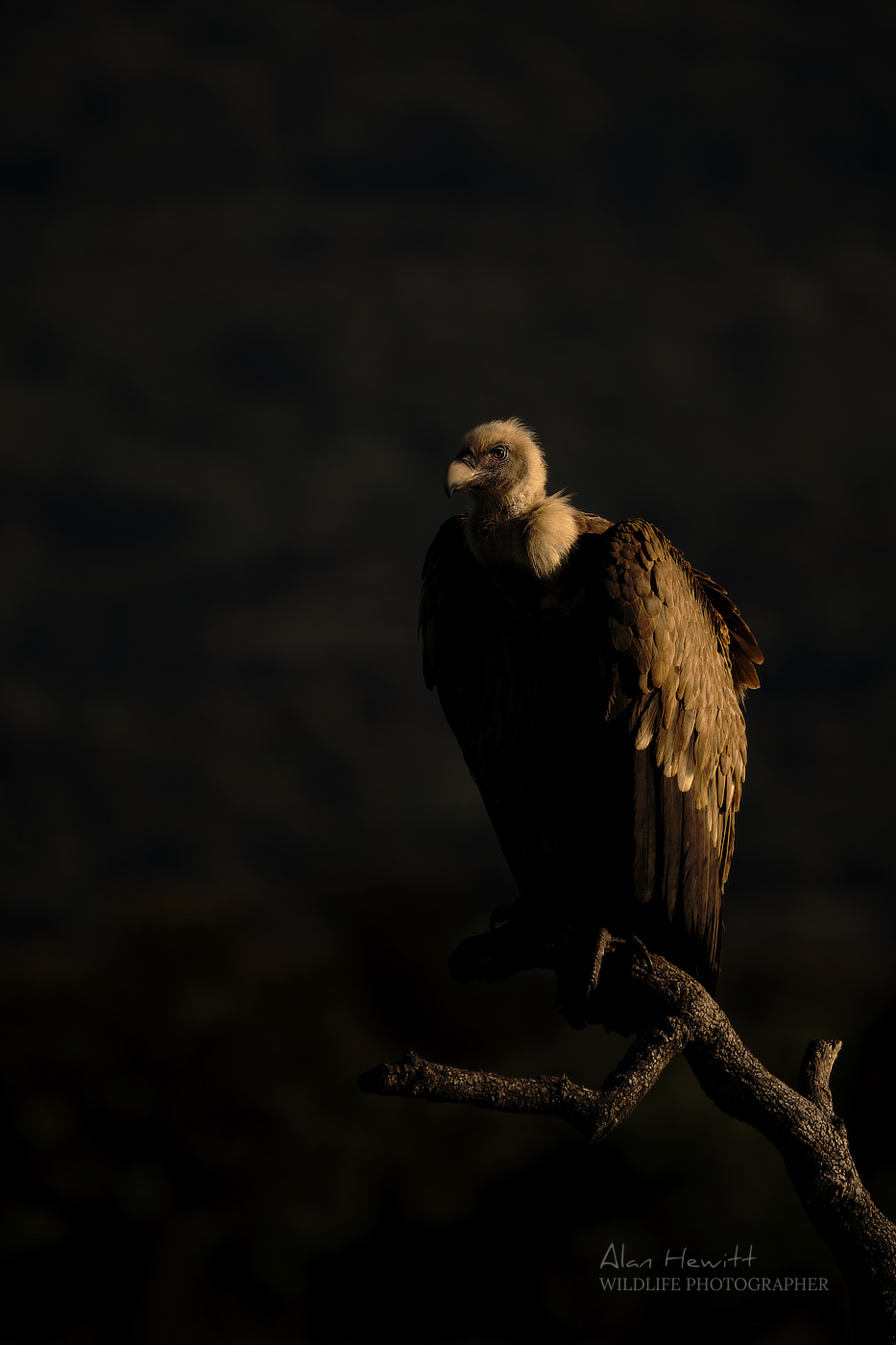
Griffon Vulture – Fujifilm X-H1 & Fujinon 100-400mm f/4.5-5.6 (1/280, f/5.6, ISO400, 400mm)
TELECONVERTERS
When I purchased the 100-400mm I opted for the package which included the 1.4x teleconverter. The performance of the 1.4x converter was also a key factor in deciding to change from Nikon to Fujifilm. More about that here.
The 100-400mm is also compatible with the 2x converter but I have no experience of using these together.
With the 1.4x attached we have a focal length of 140-560mm and an APS-C effective field of view of 210-840mm. We lose one stop on the aperture, so the lens becomes f/6.4-f/8. Communication of metering, autofocus, and image stabilisation is maintained although as we would expect, AF responsiveness does drop which is noticeable with moving subjects. However, overall sharpness remains very good. Unlike using my Nikon 200-400mm f/4 with a 1.4x converter which was noticeably soft, even visibley so on the rear monitor, I have absolutely no qualms about using the 100-400mm with the 1.4x converter if the situation calls for it.
It should also be noted that a lens firmware update is available to make the recent 1.4x f/2 converter (provided with the 200mm f/2 lens) compatible with the 100-400mm lens.
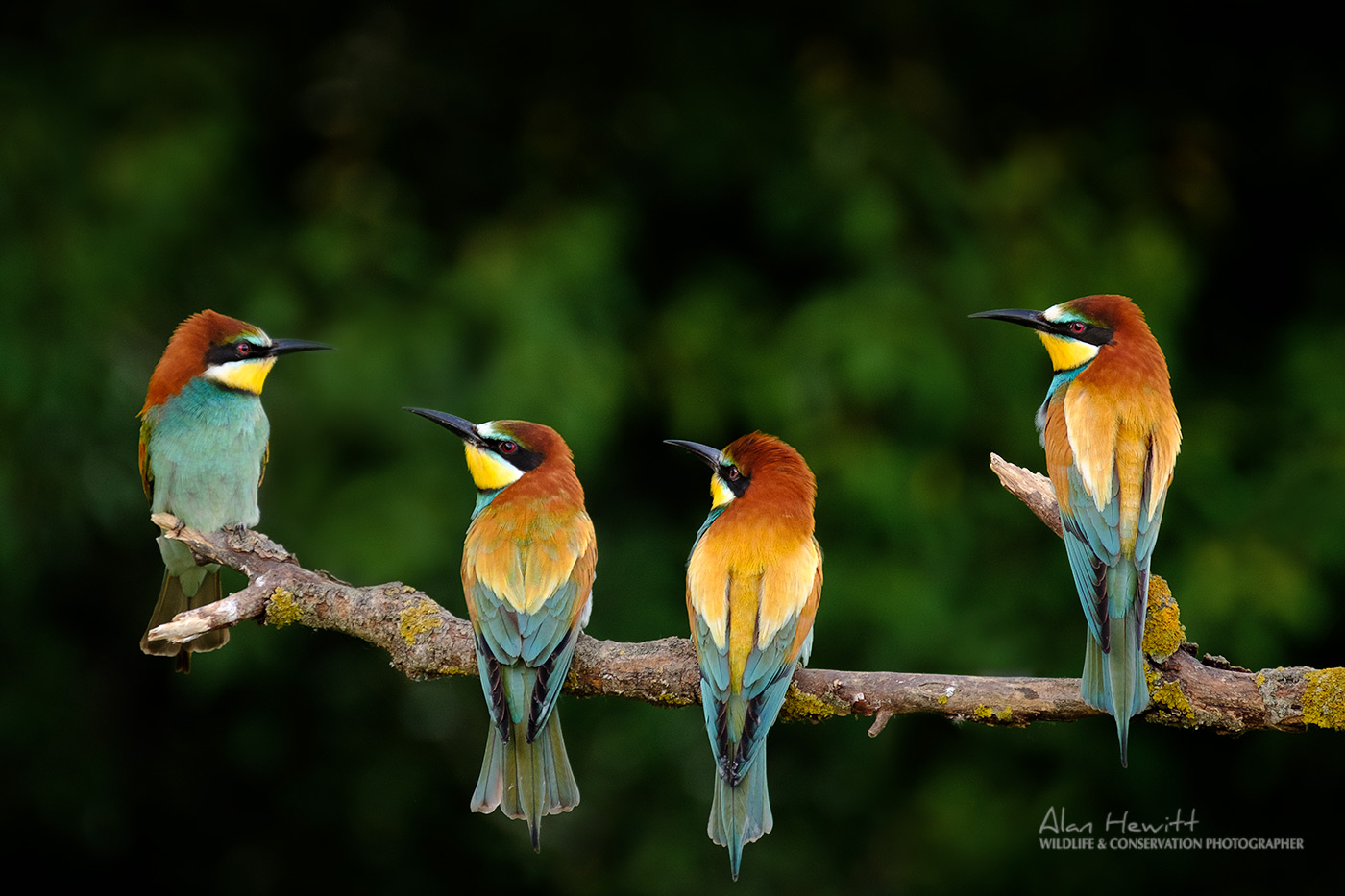
European Bee-eaters – Fujifilm X-H1 & Fujinon 100-400mm f/4.5-5.6 & 1.4x t/c (1/105, f/8, ISO800, 560mm)
(ALMOST) FINAL WORDS
The Fujinon 100-400mm has become my ‘workhorse’ lens. I was so impressed with this lens the first time I used it, its qualities became a key part of my decision to convert my equipment to the Fujifilm-X system.
That was around two years ago now, and I’m happy to say I have no regrets. Do I miss the f/4 aperture of my 200-400mm lens? Yes, but only very occasionally. But I absolutely do not miss the weight! It always feels much more liberating to be able to walk around with the X-H1 and 100-400mm using a Black Rapid shoulder strap and hand holding rather than lugging the Nikon 200-400 f/4 around with a tripod and gimbal head.
The 100-400mm is Fujifilm’s only super telephoto lens. There are no other choices beyond 280mm. The 50-140mm f/2.8 with the 2x converter or the 200mm f/2 with the 1.4x f/2 converter both max out at 280mm. I haven’t used the 50-140mm f/2.8 with a 2x converter but it is an incredible lens and I often use it for closer wildlife photography or for more ‘habitat’ or ‘wildlife in the landscape’ work. The 200mm f/2 with and without the f/2 1.4x converter is simply outstanding and I’ve enjoyed using this immensely in Kenya’s Masai Mara courtesy of Fujifilm, many thanks!
However, I am always pleased to have my 100-400mm at my side on either my X-T2 or X-H1 for its versatility and quality. For me, the 100-400mm lens made a camera system ethos I became enamoured with an absolutely viable practical and top-quality proposition for my wildlife photography. I’ve even used it to photograph the dramatic landscapes on the Isle of Skye!

Isleornsay (Skye) – Fujifilm X-H1 & Fujinon 100-400mm f/4.5-5.6 (1/30, f/11, ISO200, 143mm)
IMPROVEMENTS
If the 100-400mm lens is updated by Fujifilm, I’d love to see a few additional features considered. For example…
- A larger tripod foot which can be used for more comfortable and reassuring carrying;
- An Arca-Swiss compatible tripod foot like the 200mm f/2;
- Programmable focus memory recall buttons at the end of the lens, again like the 200mm f/2;
- Lastly, and as a bit of a ‘wild-card’, perhaps looking at the possibilty of adding an internal 1.4x converter option like the recent versions of the Canon 200-400 f/4 and Nikon 180-400 f/4;
RETAIL
Fujinon 100-400mm f/4.5-5.6 at London Camera Exchange
Fujinon 100-400mm f/4.5-5.6 & XF 1.4x TC WR at London Camera Exchange
Please note, I do not receive any affiliate benefits for these links. I choose to link to London Camera Exchange as they are also my local camera store in Newcastle upon Tyne where I purchase my own equipment and I believe in the benefits of their fantastic knowledge and service. Long live the high street camera store!
Prices correct at time of publishing, not including any periodical offers.
Fujifilm 100-400mm f/4.5-5.6 on the UK Fujifilm website.



Brilliant photographs I’ve been looking at this lens for quite a while
It’s a great lens Mickey! Like all telephotos it needs good technique too but get it right and the quality shines!
I bought this lens without the teleconverter, wish I had bought it the pack now as this is the third review where i’ve been impressed by what ive seen. Do you use the converter often?
Not very often but I have used it a fair bit in Spain and Bulgaria when the hides were a bit too far from the action than I anticipated. I was glad to have it in the bag!
You get some incredible results with the clarity with this lens they are way better than many I have seen. Whats the secret!
Thanks! Like any telephoto it needs good hand holding technique or support but with this, it’s an incredibly capable lens.
Two things to say Alan, astonished you know the third eye lid is actually called a nictitating membrane and equally astonished that you can see that level of detail in the photograph! Hope you are well! Lookng forward to catching up in South Africa in July! Jim
Ha ha, I’m pretty sure I remember telling you that!
Do you prefer the X-H1 or X-T2 with the 100-40- I hired it on my X-T3 but wondered if the X-H1 is a better grip. Great review thanks
Hi Max, I prefer the ergonomics of the X-H1 when I am using this lens. In Kenya in September I used it with the X-T2 as my X-H1 was on the 200mm f/2. I’m not saying the X-T2 was uncomfortable but the grip and shutter position feels more comfortable. Maybe it is down to familiarity too. Thanks.
Good ideas about having an integrated 1.4x like the 200-400 canon lens. It would be much quicker to use it.
Yes, sometimes it feels it would be good to have the 1.4 benefit and be able to deploy and remove it quickly.
Beautiful photographs. I’m coming to your Farne Islands days in June and I’ve been thinking about getting a lighter camera and lens than my Canon. Will you have this lens with you on the day? Would I be able to have a little cheeky try?
Thanks Mandy, look forward to meeting you and yes, I’ll have it with me and of course you can have a go and see what you think.
Amzing sharp photographs. thank you for
Thanks
Do you use a tripod mostly and what kind of tripod head is it like a gimbal?
I used to use a Wimberley Gimbal but I’m quite happy handholding the 100-400mm lens for birds in flight etc. Gimbal heads are great but no tripod head is as intuitive as panning from the hips or shoulders. I do use a tripod now and again though, sometimes in hides or a monopod. I use a monopod a fair bit in safari vehicles. With tripods and monopods I like to use a Uniqball head.
Maybe a proper review would talk about the camera settings you use for the actions phtoographs
I don’t think a lens review is the best place to talk about camera related settings, techniques or species fieldcraft. I might do a further blog on this sometime in the future though.
Is that eye piece standard on the XH1?
No, it’s a Fujifilm after-market accessory. I prefer it to help black out the viewfinder as I tend to review shots in the lovely contrasty dark viewfinder rather than the rear monitor.
Alan: Thanks! I’ve been using this lens for almost three years. My copy is shockingly sharp. It’s almost unbelievable to see the feather and hair detail in my photos. Ive also found the OIS to be exceptional. At 1/15 second handheld, I get about an 80% success rate at 400mm. At 1/30 it’s 95%. Simply incredible. I keep wondering if an X-H1 would be a better ergonomic fit than my X-T3, especially at current rock-bottom prices, but so many suggest the af on the X-H1 isn’t up to snuff compared to the X-T3. Thoughts?
Ergonomics are a very personal thing so I would give it a try and see how it feels. I have used the X-T3 and the AF is certainly more responsive and more efficient.
A great review. I’ve been enjoying getting to grips with the lens since getting it earlier this year. Agree about the tripod foot, I tend to have it on my strap and grab the foot as I walk and it is a little small to keep a good grip of.
I was impressed on the sharpness and detail pulled from a shot of the moon too, so not just for terrestrial nature!
I’d be very interested in a future blog on best settings on the Xt2.
Thanks Adam! Glad you enjoy using the lens – I’ll look into a detailed settings blog but I do have something I wrote for the Fujiholics site which may be of use: https://www.fujiholics.com/fujfilm-in-the-wild/
it’s a red billed oxpecker!!!
Nope, it’s Yellow-billed. Red-billed have an all red beak, Yellow-billed are yellow at the base then red at the tip.
I’ve been looking at this lens for so long now and have been very tempted. If you don’t mind, may I ask-
Do you need the camera to have a grip to balance it?
Is stability relevant for this if you are using high shutter speeds?
I dno’t know why the aperture markings aren’t engraved.
You say about arcaswiss – what is this?Does this mean I can’t put it on my tripod which I know is Arca
Would it not be better for sealing if the lens didn’t extend for the zoom? I have a borrowed a 70-200 f/28 for my Canon 7d which stays the same size.
Hi Rich, You don’t need the grip but I just find it balances better. Maybe it is because I am used to using a heavier combination in the past and it’s a familiarity issue rather than anything else. I do use stability as it helps keep a narrow field of view steady when composing.
The aperture rings aren’t engraved because the aperture isn’t constant, it moves automatically between f/4.5 and f/5.6 through the zoom range. So if you start at 100mm and f/4.5, by the time you get to 400mm this will have automatically changed to f/5.6 so any aperture value markings become irrelevant.
Arca Swiss are a type of tripod connector. You can buy arca swiss plates which attach to the lens tripod foot so they are compatible with arca swiss tripod heads.
You’re probably right on the sealing and fixed length zoom, but it also makes the lens permanently much bigger than it perhaps needs to be. Pretty much everything in photography is a trade-off against something else.
Awesome photo’s thanks for sharing, do you do much editing prior to showing the pics?
Do you use C or S in auto focus on birds in flight ?
Thank you, always ‘C’ continuous autofocus for moving subjects. I use Lightroom to process raw files (I should really use CaptureOne!) adjusting contrast, little bit of shadow / highlight work, white balance and look at film sims.
Lots of rumors of X-T4 coming soon – what do you think?
I’ve seen a bit of chat on Social Media. I don’t really take much interest though until official news is released.
Brilliant photography. Fujifilm isn’t a popular choice for wildlife photography but you show it can be done!
Thanks, but of course it can be done!
I just cannot get results like this. I get worried my lens is a damaged – how would you solve this.
Solving telephoto issues can be very difficult without working alongside somebody. My advice would be to research techniques for hand holding and tripod etc. Maybe think about trying to book on a wildlife photography techniques workshop where you can learn a great deal of techniques and iron out some problems.
Hi Alan,
Thank you for this great review, beautiful pictures!
I just got this lens with the teleconverter and the X-H1. Your reviews are very helpful to get started with this kit.
Could you tell what camera bag you are using and if you are happy with it? I?m baffled by the choice there is.
Thank you and looking forward to your next review,
Nadia
Hi Nadia, Thank you. I use a couple of different camera bags – this one from Manfrotto (redbee-210) and when I am flying anywhere I use this ThinkTank Airport Commuter. I usually carry at least two bodies and another couple of lenses too so if you were only carrying a camera and the 100-400mm, you could probably use a smaller bag.
When used with a gimbal tripod, what is your experience on Image Stabilization? On or Off.
Thanks
If I was using my 100-400 on a gimbal head I would usually keep stability on. If I was locked down on any other tripod head, or if the gimbal head was locked down then I would switch it off.
Hi Alan, just made the follow on your instagram. Amazing pictures, I am sure resulting of a great technique. Struggling for a sharp action sports pictures. Maybe ‘asking too much’ of my xf50140. Looking for the 100-400, as windsurf is usual, at least, a soccer field distance. Got acquainted with your work through the Fuji newsletter (July 20th). Stoke with your image detail and wondering what are your average settings, as it shouldn’t be very different when comparing to action sports.
I’m on AF-C using alternatively Zone Area (not sure if 3×3, 5×5 have to cover the subject) and single point. My biggest challenge is to get the athlete’s face sharp, which is rare ;( – I accept if here is not the proper place, if so, would you point the right direction? Cheers Carlos
Hi Alan,
Sorry I’m so late in commenting, I just discovered this review. I notice you appear to use a larger eye cup on the X-H1. Is this a Fuji part or third party?
Also, concerning the Lens tripod foot. It’s even smaller than the 50-140mm. Do you just use an Arca plate attached to it or some other solution.
Thanks. Great images and a stellar lens and review.
Hi, thanks! The eye cup is a FUJIFILM part: https://shop.fujifilm.co.uk/fujifilm-x-h1-eye-cup. It’s great for creating a dark contrasty viewfinder to review images through! However, it doesn’t work well with the X-T4 due to the articulating screen. I now use an Arca Swiss compatible plate with my lenses but one made by Black Rapid. It is the Black Rapid tripod plate 70. It also has a loop attachment for Black Rapid slings underneath.
Alan,
Thanks for your swift reply.
I have and X-H1 and an X-T3. I recently picked up the XF 100-400mm on a Fuji sale that was too good to ignore.
Do you find that the eye cup also enhances your view as you shoot?
As far as the tripod foot I use Peak Design straps but after carrying the zoom I’m thinking I need to attach something to the lens and body to make it easy on the mount and reduce the amount of had carrying.
Thanks again. Great blog. Excellent images.